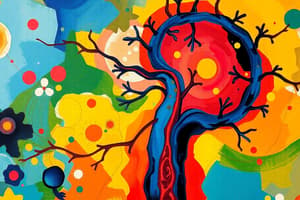Podcast
Questions and Answers
What is a key difference between acute and chronic inflammation?
What is a key difference between acute and chronic inflammation?
- Acute inflammation lasts longer than chronic inflammation.
- Acute inflammation usually has fewer lymphocytes compared to chronic inflammation.
- Chronic inflammation has a shorter duration than acute inflammation.
- Chronic inflammation occurs after a delay compared to acute inflammation. (correct)
Which cells are predominantly involved in chronic inflammation?
Which cells are predominantly involved in chronic inflammation?
- Eosinophils
- Lymphocytes (correct)
- Neutrophils
- Basophils
What systemic impact can chronic inflammation have on a patient?
What systemic impact can chronic inflammation have on a patient?
- It enhances the immune response significantly.
- It is less likely to cause tissue damage compared to acute inflammation.
- It can lead to a more fibrotic appearance in tissues. (correct)
- It generally resolves faster than acute inflammation.
What is a likely outcome if the host defense cannot clear the insult in chronic inflammation?
What is a likely outcome if the host defense cannot clear the insult in chronic inflammation?
Which of the following statements is true about the duration of acute and chronic inflammation?
Which of the following statements is true about the duration of acute and chronic inflammation?
What initiates the epithelial cell proliferation during primary healing?
What initiates the epithelial cell proliferation during primary healing?
What is a characteristic of the maturation phase in primary healing?
What is a characteristic of the maturation phase in primary healing?
What distinguishes the inflammatory phase of secondary healing from primary healing?
What distinguishes the inflammatory phase of secondary healing from primary healing?
How does collagen behave during the maturation phase of wound healing?
How does collagen behave during the maturation phase of wound healing?
What causes the unevenness of scar tissue in secondary healing?
What causes the unevenness of scar tissue in secondary healing?
Which factor is NOT classified as a local factor affecting wound healing?
Which factor is NOT classified as a local factor affecting wound healing?
What role do myofibroblasts play in the proliferative phase of secondary healing?
What role do myofibroblasts play in the proliferative phase of secondary healing?
What is the typical timeframe for a clot to become a scab in the healing process?
What is the typical timeframe for a clot to become a scab in the healing process?
What type of wound is characterized by the skin being broken?
What type of wound is characterized by the skin being broken?
Which of the following is NOT a risk factor for developing a wound?
Which of the following is NOT a risk factor for developing a wound?
What is the first stage of primary wound healing?
What is the first stage of primary wound healing?
Which type of wound healing involves regeneration and typically results in minimal scarring?
Which type of wound healing involves regeneration and typically results in minimal scarring?
What type of wound is likely to become infected?
What type of wound is likely to become infected?
Which of the following best describes a laceration?
Which of the following best describes a laceration?
What is a common complication associated with wound healing?
What is a common complication associated with wound healing?
Which factor does NOT influence tissue healing?
Which factor does NOT influence tissue healing?
Which of the following is NOT a complication of wound healing?
Which of the following is NOT a complication of wound healing?
Which complication is characterized by the separation of the layers of a surgical site?
Which complication is characterized by the separation of the layers of a surgical site?
What is a common outcome of infection during wound healing?
What is a common outcome of infection during wound healing?
Which condition is represented by an abnormal connection between organs or vessels that may occur after surgery?
Which condition is represented by an abnormal connection between organs or vessels that may occur after surgery?
Which complication involves excessive fibrous tissue formation at the wound site?
Which complication involves excessive fibrous tissue formation at the wound site?
What describes the risk associated with a wound healing improperly due to lack of nutrition?
What describes the risk associated with a wound healing improperly due to lack of nutrition?
Which complication of wound healing can lead to the formation of a thick, raised scar?
Which complication of wound healing can lead to the formation of a thick, raised scar?
Which is a typical consequence of successful wound healing?
Which is a typical consequence of successful wound healing?
Flashcards are hidden until you start studying
Study Notes
Inflammation
- Acute inflammation is the body's initial response to injury or infection and is characterized by a short duration.
- Chronic inflammation occurs after a delay and is characterized by a longer duration.
- The main inflammatory cells in acute inflammation are neutrophils, in contrast to chronic inflammation where lymphocytes dominate.
- Chronic inflammation is likely to lead to more tissue damage and may have a fibrotic appearance.
Granulomas
- Chronic inflammation can lead to granuloma formation, which are areas of inflammation encased in a fibrous wall.
- Granuloma formation is the body's way of isolating and containing the irritant to prevent further spread.
- Granulomas can cause symptoms depending on their size and location, and may require further investigation.
Wound Healing
- Surgical incisions, trauma, pressure, friction, poor circulation, medical therapies, age, disease processes, heredity and nutrition can all lead to the development of wounds.
- Wounds can be intentional, unintentional, open, closed, clean, contaminated, or infected.
Describing Wounds
- Abrasion - a scrape
- Contusion - a bruise
- Incision - a clean cut
- Laceration - a jagged tear
- Penetrating wound - a wound where an object enters the body
- Puncture wound - a wound from a pointed object entering the body
Factors Influencing Tissue Healing
- The presence of foreign bodies and pathogens, the extent of damage, the body's response, and the health status of the individual all influence tissue healing.
Stages of Wound Healing
- Primary healing (first intention) refers to wounds with minimal tissue loss and edges that are close together.
- Secondary healing (second intention) refers to wounds with extensive tissue loss, often requiring a longer healing timeframe.
- Tertiary intention involves delayed closure of a wound that has been open for a period of time.
Wound Healing Stages (in detail)
- Inflammation (Primary Healing)
- Begins within the first few hours after injury and includes inflammation, blood clot formation, and influx of white blood cells.
- Proliferation (Primary Healing)
- Overlaps the inflammatory stage.
- Epithelial cells begin to cover the wound.
- New blood vessels form (angiogenesis).
- Granulation tissue forms, which is a soft, red, and delicate tissue that fills in the wound.
- Wound contraction occurs.
- The blood clot becomes a scab which separates after 3-10 days.
- Maturation (Primary Healing)
- Collage begins to degrade as it is produced.
- Maturation begins when collagen production equals collagen degradation.
- Can last for a year or more.
- Stronger collagen is laid down.
- Blood vessels are removed, and the scar gradually loses its redness.
Wound Healing Stages (in detail - Secondary Healing)
- Inflammation (Secondary Healing)
- More intense than primary healing.
- Necrotic tissue forms, which sloughs off the top of the wound.
- Healing occurs by an indirect union of granulating surfaces.
- Proliferation (Secondary Healing)
- Similar to primary healing, but more intense.
- Increased activity of phagocytes.
- Rich blood supply to reduce and prevent infection.
- Granulation tissue forms at the base of the wound.
- Fibroblasts convert to myofibroblasts, initiating contraction of the wound.
- Maturation (Secondary Healing)
- Collagen is laid down horizontally.
- Wound contraction is prominent.
- Tissue is uneven, resulting in scar tissue.
Comparing Primary & Secondary Healing
- Primary healing: occurs in wounds with minimal tissue loss.
- Secondary healing: occurs in wounds with extensive tissue loss, leading to scarring and a longer healing time.
Tertiary Healing
- Delayed closure of a wound that has been open for a period of time, typically used for heavily contaminated wounds or wounds with ongoing infection.
Factors Affecting Wound Healing
- Local Factors:
- Ischemia (reduced blood flow)
- Foreign bodies
- Infection
- Systemic Factors:
- Age & gender
- Hormones
- Nutrition
- Immunocompromised status
- Stress
- Diseases
- Alcoholism
- Medication
- Obesity
Complications of Wound Healing
- Haemorrhage: excessive bleeding
- Infection: contamination of the wound by bacteria or other pathogens
- Dehiscence: splitting open of the wound
- Fistula: an abnormal connection between two organs or structures
- Keloid scar: raised, thick, and often disfiguring scar
Studying That Suits You
Use AI to generate personalized quizzes and flashcards to suit your learning preferences.




